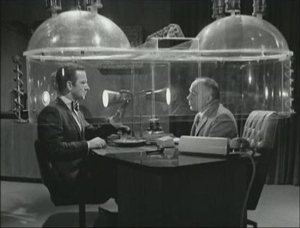Congratulations on founding your CAB. But how do you ensure a safe and secure format for discussing delicate, strategic topics? Do you need a non-disclosure agreement for your Customer Advisory Board? Here are three unspoken truths about NDAs that should not be kept secret.
“Exercise caution in your business affairs, for the world is full of trickery.” This line in Max Erhmann’s poem, Desiderata, states a sad but true fact: we must always be vigilant and cognizant of the information we choose to share with our partners and customers. More important than growing revenue is protecting our trade secrets and respecting the privacy of our customers. Because if we screw up the latter, we’ll never achieve the former. Nowhere is this more relevant than with the CAB. Here are three truths about NDAs and your CAB:

The “cone of silence” was frequently used by Agent 86 and the Chief in sharing secrets, in the TV show Get Smart!
1) Yes, you need an NDA.
2) The NDA will give you a false sense of security.
3) There is no replacement for personal trust.
While the NDA provides a foundation for setting expectations of a safe and secure “cone of silence”, it is not enough to establish the trust you need to ensure a productive meeting and a lasting relationship with your best, most strategic customers. The NDA is the first line of defense, but it’s focus is on legal matters, expectations, restrictions and penalties — the exact opposite of what a CAB stands for (i.e. vision, cooperation, creativity, and open and honest dialog).
We need an NDA to reinforce the seriousness of our CAB. We expect all participants to follow the rules of proper business conduct with respect. Failure to adhere to good citizenship will be cause for ejection from the CAB. But the NDA can lead to a false sense of security because it says nothing about how the meetings will be conducted and how the group will use the information for mutual advantage.
The CAB leader or executive sponsor must clearly communicate the rules of engagement, including aspects like term of participation, topics that will be covered, topics not covered, how often the group will meet, and how the conversations can continue between CAB meetings. CAB etiquette must be continuously reinforced in your writings and actions with CAB members and your staff. If the host company follows these rules of conduct, so will the CAB participants. The success of your CAB program depends on the level of personal trust you engender, not legal documentation.
Trust is built on relationships that are familiar, friendly, and aligned. And trust can only grow based on experience — experiences shared when even though your customers are competitors today, they may be partners tomorrow (or vice versa). It’s complicated. It’s like walking a tightrope.
Walking the CAB tightrope
One particular customer had agreed to host a factory tour prior to a CAB meeting. As the facilitator prepping for the meeting, I was eager to learn more. As I began the interview, he interrupted me with the following remarks, “Mike, I will not share any information about what we are doing because I don’t want my competitors to learn about it.” Fair enough. I reminded him that this interview was strictly confidential in order to help us form the most productive agenda. We talked about industry trends and drivers and how his company was responding. What interested me was how his leadership team was making progress in light of an uncertain and transforming market and how and why his factories had adopted creative new practices to streamline production. I could not help but be inspired by his creative approach to problem-solving. When we concluded the interview I was both excited and confused. His stories were rich with insight; yet, I couldn’t reconcile this with his introductory comment. He knew which competitors, partners, and peers would be attending the CAB meeting. If he didn’t want to share some of this information, why had he agreed to host a pre-CAB tour? Gently, I asked him to confirm his willingness to share the tour and his stories (as much as he was comfortable). He answered with an emphatic, “yes!”
The tour turned out to be one of the highlights of the CAB meeting. The group was extremely impressed, generating a lot of cross-customer discussion that benefited the customer tour guide beyond his expectations.
Security is in the eye of the beholder
You may be thinking, “was the tour a disaster waiting to happen?” No, absolutely not. The tour focused on operational best practices, not company trade secrets. And the customer providing the tour was very comfortable guiding the conversation on what he considered “safe ground”. The other customers ate it up. Let me assure you that the senior executives who typically attend CAB meetings are very savvy, experienced people with fiduciary responsibilities. They know what they can share and what they won’t share. They know where the line in the sand is for them. And as the meeting unfolds, and as the group gets to know each other better, the line in the sand may be relaxed. In the end, it’s all about trust.
The CAB meetings are never about prying details out of any customer’s business plan. We are not talking about sharing obvious elements of competitive differentiation like the recipe for Coke or Pepsi. Instead, the meetings are about looking to the future and how we can provide guidance to the host vendor and cooperate to drive an industry forward. Neither the host company nor the facilitator can define where that line in the sand is. And so, we must rely on the customers to share what they are willing to share, and nothing more. In practice, our most important job (yours as the CAB host and mine as the facilitator) is to establish a safe, collaborative environment where we can learn from each other. This level of trust starts but does not end with an NDA.
What to read next: The perfect agenda for your CAB meeting


You must be logged in to post a comment.